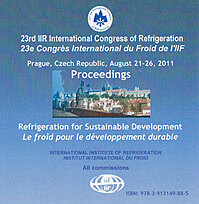
Document IIF
Effet de la fraction du volume des particules sur le transfert de chaleur par pulvérisation d'un nanofrigorigène Al2O3-eau.
Effect of particle volume fraction on spray heat transfer using Al2O3-water nanofluid.
Numéro : pap. ID: 197
Auteurs : CHANG T. B., SYU S. C., YANG Y. K.
Résumé
The spray cooling is a very effective heat transfer mode. Using a 35-nm Al2O3-particle–water nanofluid as working fluid, the effects of particle volume fraction on the spray heat transfer performance were investigated experimentally in this study. The tested surface was a flat, horizontal and circular heated surface. The tests were realized for the following ranges of the governing parameters: the nozzle orifice diameter is 2.3 mm and the distance nozzle-to-heated-surface was set to 17 mm; the spray mass flow rate varies from 0.021 to 0.056 kg/s. In addition, four different particle volume fractions (0, 0.001, 0.025, and 0.05 Vol%) were specially prepared to determine the proper particle volume fraction. It is shown that the optimal heat transfer performance is obtained using a particle volume fraction of 0.001 Vol%. After finishing spray cooling experiments, SEM was used to analyze the compositions of various heated surfaces for different particle volume fractions. A few Al-elements were detected on heated surface for 0.025 and 0.05 Vol% but no Al was found for 0 and 0.001Vol%.
Documents disponibles
Format PDF
Pages : 9 p.
Disponible
Prix public
20 €
Prix membre*
Gratuit
* meilleur tarif applicable selon le type d'adhésion (voir le détail des avantages des adhésions individuelles et collectives)
Détails
- Titre original : Effect of particle volume fraction on spray heat transfer using Al2O3-water nanofluid.
- Identifiant de la fiche : 30001630
- Langues : Anglais
- Source : Proceedings of the 23rd IIR International Congress of Refrigeration: Prague, Czech Republic, August 21-26, 2011. Overarching theme: Refrigeration for Sustainable Development.
- Date d'édition : 21/08/2011
Liens
Voir d'autres communications du même compte rendu (569)
Voir le compte rendu de la conférence
Indexation
-
Effect of inclination angles on the heat transf...
- Auteurs : KIM W. H., KIM M. H., CHOI J. C., et al.
- Date : 04/12/2002
- Langues : Anglais
- Source : Green breeze from Asia: frontiers of refrigerants, heat transfer and system.. ACRA-2002. Proceedings of the Asian conference on refrigeration and air conditioning.
Voir la fiche
-
An inverse model for transient cooling and dehu...
- Auteurs : ZHOU X., BRAUN J. E.
- Date : 19/01/2008
- Langues : Anglais
- Source : ASHRAE Transactions. 2008 Winter Meeting, New York City, NY. Volume 114, part 1 + CD-ROM.
Voir la fiche
-
A novel dehumidification system using zeotropic...
- Auteurs : LIU X., LIANG X., HUANG M.
- Date : 24/08/2019
- Langues : Anglais
- Source : Proceedings of the 25th IIR International Congress of Refrigeration: Montréal , Canada, August 24-30, 2019.
- Formats : PDF
Voir la fiche
-
Airside thermal performance of micro-channel he...
- Auteurs : KIM M. H., BULLARD C. W.
- Date : 25/07/2000
- Langues : Anglais
- Source : Proceedings of the 2000 International Refrigeration Conference at Purdue.
Voir la fiche
-
A theory for heat exchangers with liquid-desicc...
- Auteurs : OTTERBEIN R. T.
- Date : 01/1995
- Langues : Anglais
- Source : ASHRAE Transactions.
Voir la fiche
